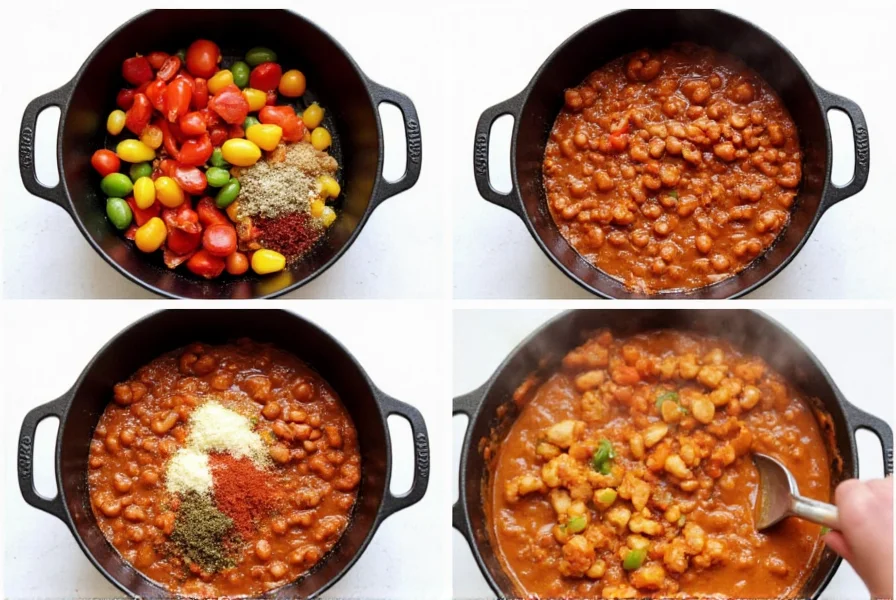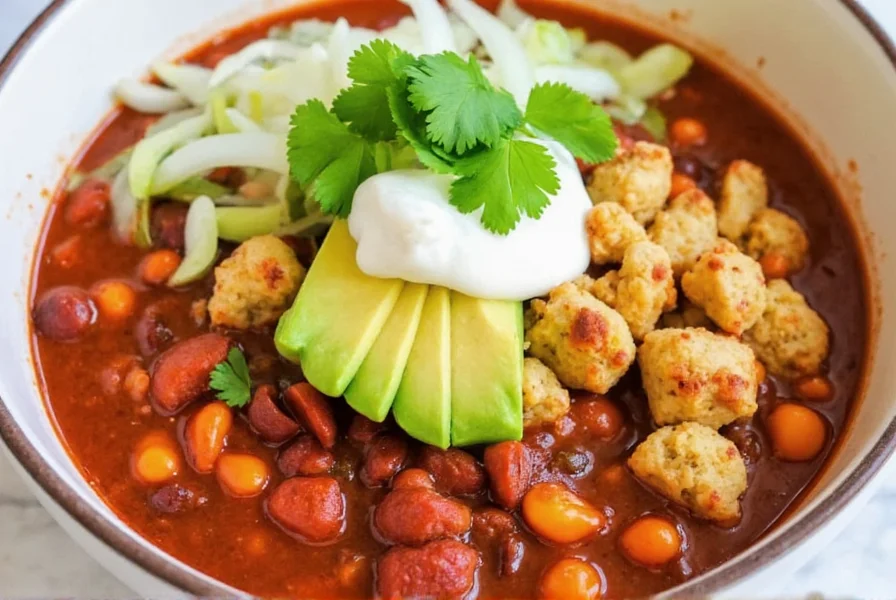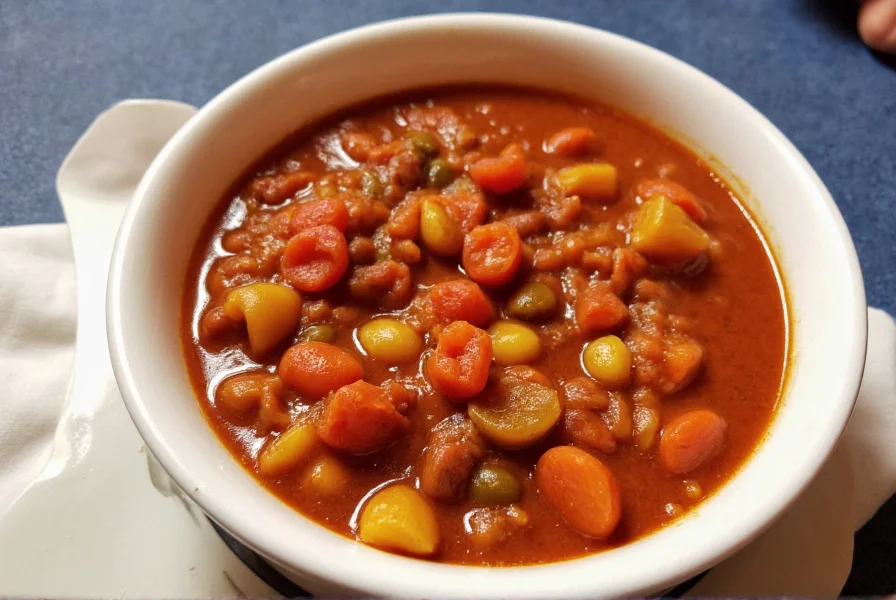The best veggie chili combines hearty beans, roasted vegetables, and a rich blend of spices for a satisfying meatless meal. Our tested recipe features kidney beans, black beans, fire-roasted tomatoes, bell peppers, and a signature spice mix including cumin, smoked paprika, and chipotle powder. Simmered for 30 minutes to develop deep flavors, this vegetarian chili serves 6 and can be customized for spice level, dietary needs, and cooking methods. It's naturally gluten-free, packed with 15g protein per serving, and freezes beautifully for up to 3 months.
Vegetarian chili has evolved from a simple meat substitute to a celebrated dish in its own right. Far from being just "chili without meat," the best veggie chili recipes leverage the natural textures and flavors of plant-based ingredients to create something uniquely delicious. Whether you're cooking for dietary preferences, health reasons, or simply to enjoy a hearty meatless meal, understanding the components that make vegetarian chili exceptional will transform your cooking.

The Essential Components of Flavorful Veggie Chili
Creating exceptional vegetarian chili requires understanding how different elements contribute to the final dish. Unlike traditional chili that relies on meat for depth, veggie chili needs strategic layering of flavors and textures.
Bean Selection and Preparation
Beans form the protein foundation of any great vegetarian chili. The ideal combination includes:
| Bean Type | Flavor Profile | Texture Contribution | Preparation Tip |
|---|---|---|---|
| Kidney Beans | Earthy, slightly sweet | Firm, holds shape well | Add in last 15 minutes to maintain texture |
| Black Beans | Earthy, slightly metallic | Creamy interior, firm exterior | Add early to absorb flavors |
| Pinto Beans | Nutty, mild | Softens significantly when cooked | Mash slightly to thicken chili |
For canned beans, always rinse thoroughly to remove excess sodium and the starchy liquid that can make chili gluey. If using dried beans, soak overnight and cook separately until just tender before adding to your chili base.
Vegetable Foundation
The vegetable base creates both texture and flavor complexity. While traditional recipes might use onions and garlic as a base, expanding your mirepoix creates more dimension:
- Bell peppers (especially roasted) add sweetness and depth
- Carrots provide natural sweetness that balances acidity
- Mushrooms (portobello or cremini) contribute umami and meaty texture
- Zucchini or eggplant add body without overpowering flavor
For maximum flavor development, roast vegetables before adding them to your chili. This caramelization process creates complex compounds that simulate the Maillard reaction typically achieved with meat browning.
Mastering the Spice Profile
Spices make or break vegetarian chili. The right combination creates warmth, depth, and complexity that compensates for the absence of meat. Our recommended spice blend includes:
- 2 tbsp chili powder - provides base flavor
- 1½ tsp cumin - earthy backbone
- 1 tsp smoked paprika - adds depth and smokiness
- ½ tsp chipotle powder - for heat and complexity
- 1 tsp oregano - herbal note
- ½ tsp cocoa powder - enhances richness (secret ingredient!)
The key to perfect spice integration is blooming your spices. Add them to the pot with a small amount of oil and the vegetable base, cooking for 1-2 minutes before adding liquids. This process releases essential oils and creates a flavor foundation that permeates the entire dish.
Avoiding Common Veggie Chili Mistakes
Even experienced cooks can stumble with vegetarian chili. Here are frequent pitfalls and how to avoid them:
Watery Consistency
Without meat to absorb liquid, veggie chili can become too thin. Fix this by:
- Using fire-roasted tomatoes (they're thicker than regular crushed tomatoes)
- Mashing ¼ of the beans before adding
- Simmering uncovered for the last 15 minutes
- Adding a tablespoon of masa harina (corn flour) to thicken
Lack of Depth
Meat provides umami that's missing in vegetarian versions. Compensate with:
- Tomato paste browned in the pot before adding other ingredients
- Mushrooms (especially dried porcini, rehydrated and chopped)
- A splash of soy sauce or tamari (gluten-free option)
- 1-2 teaspoons of nutritional yeast
- A small piece of dark chocolate (70% cacao or higher)
Variations for Every Preference
One of the beauties of veggie chili is its adaptability. Here are popular variations that maintain the core integrity while offering different experiences:
Southwest Black Bean Chili
Features black beans as the primary protein with corn, lime juice, and cilantro. Add 1 diced avocado during the last 5 minutes of cooking for creaminess. Perfect for those seeking a lighter, brighter flavor profile.
Three-Bean Hearty Chili
Combines kidney beans, pinto beans, and cannellini beans for varied texture. Add roasted sweet potatoes for extra heartiness. Ideal for cold weather and satisfying for meat-eaters.
White Bean Chicken-Style Chili
Uses white beans, green chilies, and cumin for a completely different color profile. Add chopped hearts of palm to mimic chicken texture. Great for those who prefer milder spice levels.

Serving and Storage Guidelines
Proper serving enhances your veggie chili experience, while correct storage maintains quality for future meals.
Recommended Toppings
The right toppings add contrasting textures and flavors that elevate your chili:
- Fresh cilantro (adds brightness)
- Lime wedges (cuts through richness)
- Avocado or guacamole (adds creaminess)
- Sour cream or Greek yogurt (cools spice)
- Shredded cheese (cheddar or Monterey Jack)
- Green onions (for color and mild onion flavor)
- Tortilla chips (for crunch)
Storage Instructions
Veggie chili often tastes better the next day as flavors continue to meld. Follow these storage guidelines:
- Cool completely before storing (prevents condensation)
- Store in airtight containers for up to 5 days in the refrigerator
- Freeze in portion-sized containers for up to 3 months
- When reheating, add a splash of water or broth if too thick
- Never reheat chili more than once for food safety
Nutritional Benefits of Veggie Chili
Beyond its delicious flavor, veggie chili offers impressive nutritional advantages. A standard serving (1½ cups) typically contains:
- 15-18g plant-based protein from the combination of beans and grains
- 12-15g dietary fiber supporting digestive health
- Rich in iron, magnesium, and B vitamins from beans and vegetables
- Low in saturated fat compared to meat-based versions
- Antioxidant-rich from tomatoes, peppers, and spices
The fiber content in particular makes veggie chili exceptionally satisfying. Studies show high-fiber meals promote satiety and help maintain stable blood sugar levels, making this dish not just delicious but genuinely nourishing.
Frequently Asked Questions
Can I make veggie chili in a slow cooker?
Yes, slow cooker veggie chili works exceptionally well. Sauté vegetables and spices first, then transfer to the slow cooker with remaining ingredients. Cook on low for 6-8 hours or high for 3-4 hours. The extended cooking time allows flavors to develop beautifully while requiring minimal attention.
How can I make my veggie chili spicier without overwhelming heat?
For complex heat without just burning spice, add chipotle peppers in adobo sauce (start with 1 pepper, finely chopped), a pinch of cayenne, or a few dashes of hot sauce with smoked ingredients. The key is balancing heat with other flavors rather than just increasing capsaicin levels.
What's the best way to freeze veggie chili for meal prep?
Cool chili completely, then portion into freezer-safe containers leaving 1-inch headspace for expansion. For easiest use, freeze in single-serving portions. Lay containers flat initially to freeze, then stack once solid. Properly frozen veggie chili maintains quality for 3 months. Thaw overnight in the refrigerator before reheating.
Why does my veggie chili taste bland even with plenty of spices?
Bland veggie chili often results from not blooming spices properly or insufficient acid balance. Always cook spices in oil for 1-2 minutes before adding liquids to release their essential oils. Additionally, finish with a splash of acid (lime juice, apple cider vinegar, or even a bit of tomato paste) to brighten flavors. Taste and adjust seasoning at the end of cooking.
Can I make veggie chili without tomatoes?
Yes, tomato-free veggie chili is possible. Substitute with roasted red pepper puree, butternut squash puree, or even beets for color and sweetness. You'll need to adjust spices accordingly, as tomatoes provide acidity that balances the dish. Add a tablespoon of vinegar or lemon juice to compensate for the missing acidity.











 浙公网安备
33010002000092号
浙公网安备
33010002000092号 浙B2-20120091-4
浙B2-20120091-4